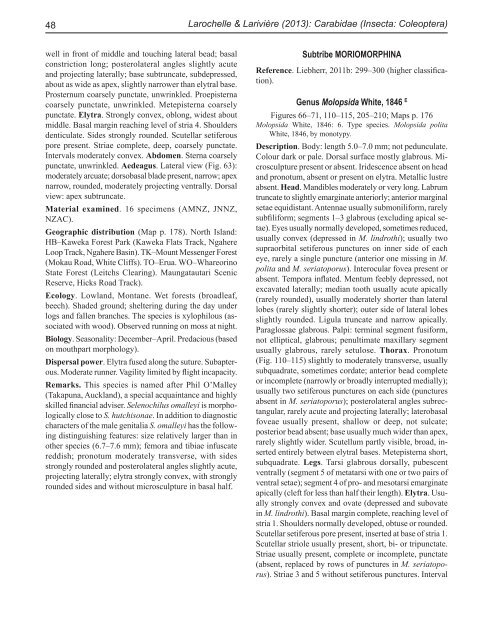Fauna of New Zealand 69 - Landcare Research
Fauna of New Zealand 69 - Landcare Research
Fauna of New Zealand 69 - Landcare Research
You also want an ePaper? Increase the reach of your titles
YUMPU automatically turns print PDFs into web optimized ePapers that Google loves.
48<br />
well in front <strong>of</strong> middle and touching lateral bead; basal<br />
constriction long; posterolateral angles slightly acute<br />
and projecting laterally; base subtruncate, subdepressed,<br />
about as wide as apex, slightly narrower than elytral base.<br />
Prosternum coarsely punctate, unwrinkled. Proepisterna<br />
coarsely punctate, unwrinkled. Metepisterna coarsely<br />
punctate. Elytra. Strongly convex, oblong, widest about<br />
middle. Basal margin reaching level <strong>of</strong> stria 4. Shoulders<br />
denticulate. Sides strongly rounded. Scutellar setiferous<br />
pore present. Striae complete, deep, coarsely punctate.<br />
Intervals moderately convex. Abdomen. Sterna coarsely<br />
punctate, unwrinkled. Aedeagus. Lateral view (Fig. 63):<br />
moderately arcuate; dorsobasal blade present, narrow; apex<br />
narrow, rounded, moderately projecting ventrally. Dorsal<br />
view: apex subtruncate.<br />
Material examined. 16 specimens (AMNZ, JNNZ,<br />
NZAC).<br />
Geographic distribution (Map p. 178). North Island:<br />
HB–Kaweka Forest Park (Kaweka Flats Track, Ngahere<br />
Loop Track, Ngahere Basin). TK–Mount Messenger Forest<br />
(Mokau Road, White Cliffs). TO–Erua. WO–Whareorino<br />
State Forest (Leitchs Clearing). Maungatautari Scenic<br />
Reserve, Hicks Road Track).<br />
Ecology. Lowland, Montane. Wet forests (broadleaf,<br />
beech). Shaded ground; sheltering during the day under<br />
logs and fallen branches. The species is xylophilous (associated<br />
with wood). Observed running on moss at night.<br />
Biology. Seasonality: December–April. Predacious (based<br />
on mouthpart morphology).<br />
Dispersal power. Elytra fused along the suture. Subapterous.<br />
Moderate runner. Vagility limited by flight incapacity.<br />
Remarks. This species is named after Phil O’Malley<br />
(Takapuna, Auckland), a special acquaintance and highly<br />
skilled financial adviser. Selenochilus omalleyi is morphologically<br />
close to S. hutchisonae. In addition to diagnostic<br />
characters <strong>of</strong> the male genitalia S. omalleyi has the following<br />
distinguishing features: size relatively larger than in<br />
other species (6.7–7.6 mm); femora and tibiae infuscate<br />
reddish; pronotum moderately transverse, with sides<br />
strongly rounded and posterolateral angles slightly acute,<br />
projecting laterally; elytra strongly convex, with strongly<br />
rounded sides and without microsculpture in basal half.<br />
Larochelle & Larivière (2013): Carabidae (Insecta: Coleoptera)<br />
Subtribe MORIOMORPHINA<br />
Reference. Liebherr, 2011b: 299–300 (higher classification).<br />
Genus Molopsida White, 1846 E<br />
Figures 66–71, 110–115, 205–210; Maps p. 176<br />
Molopsida White, 1846: 6. Type species. Molopsida polita<br />
White, 1846, by monotypy.<br />
Description. Body: length 5.0–7.0 mm; not pedunculate.<br />
Colour dark or pale. Dorsal surface mostly glabrous. Microsculpture<br />
present or absent. Iridescence absent on head<br />
and pronotum, absent or present on elytra. Metallic lustre<br />
absent. Head. Mandibles moderately or very long. Labrum<br />
truncate to slightly emarginate anteriorly; anterior marginal<br />
setae equidistant. Antennae usually submoniliform, rarely<br />
subfiliform; segments 1–3 glabrous (excluding apical setae).<br />
Eyes usually normally developed, sometimes reduced,<br />
usually convex (depressed in M. lindrothi); usually two<br />
supraorbital setiferous punctures on inner side <strong>of</strong> each<br />
eye, rarely a single puncture (anterior one missing in M.<br />
polita and M. seriatoporus). Interocular fovea present or<br />
absent. Tempora inflated. Mentum feebly depressed, not<br />
excavated laterally; median tooth usually acute apically<br />
(rarely rounded), usually moderately shorter than lateral<br />
lobes (rarely slightly shorter); outer side <strong>of</strong> lateral lobes<br />
slightly rounded. Ligula truncate and narrow apically.<br />
Paraglossae glabrous. Palpi: terminal segment fusiform,<br />
not elliptical, glabrous; penultimate maxillary segment<br />
usually glabrous, rarely setulose. Thorax. Pronotum<br />
(Fig. 110–115) slightly to moderately transverse, usually<br />
subquadrate, sometimes cordate; anterior bead complete<br />
or incomplete (narrowly or broadly interrupted medially);<br />
usually two setiferous punctures on each side (punctures<br />
absent in M. seriatoporus); posterolateral angles subrectangular,<br />
rarely acute and projecting laterally; laterobasal<br />
foveae usually present, shallow or deep, not sulcate;<br />
posterior bead absent; base usually much wider than apex,<br />
rarely slightly wider. Scutellum partly visible, broad, inserted<br />
entirely between elytral bases. Metepisterna short,<br />
subquadrate. Legs. Tarsi glabrous dorsally, pubescent<br />
ventrally (segment 5 <strong>of</strong> metatarsi with one or two pairs <strong>of</strong><br />
ventral setae); segment 4 <strong>of</strong> pro- and mesotarsi emarginate<br />
apically (cleft for less than half their length). Elytra. Usually<br />
strongly convex and ovate (depressed and subovate<br />
in M. lindrothi). Basal margin complete, reaching level <strong>of</strong><br />
stria 1. Shoulders normally developed, obtuse or rounded.<br />
Scutellar setiferous pore present, inserted at base <strong>of</strong> stria 1.<br />
Scutellar striole usually present, short, bi- or tripunctate.<br />
Striae usually present, complete or incomplete, punctate<br />
(absent, replaced by rows <strong>of</strong> punctures in M. seriatoporus).<br />
Striae 3 and 5 without setiferous punctures. Interval
















